
The Office of Strategic Services (OSS) was the intelligence agency of the United States during World War II. The OSS was formed as an agency of the Joint Chiefs of Staff (JCS) to coordinate espionage activities behind enemy lines for all branches of the United States Armed Forces. Other OSS functions included the use of propaganda, subversion, and post-war planning.
Special Operations Executive (SOE) was a British organisation formed in 1940 to conduct espionage, sabotage and reconnaissance in German-occupied Europe and to aid local resistance movements during World War II.

A commando is a combatant, or operative of an elite light infantry or special operations force, specially trained for carrying out raids and operating in small teams behind enemy lines.

The United States Army Special Forces (SF), colloquially known as the "Green Berets" due to their distinctive service headgear, is the special operations branch of the United States Army. Although technically an Army branch, the Special Forces operates similarly to a functional area (FA), in that individuals may not join its ranks until having served in another Army branch.

Supreme Headquarters Allied Expeditionary Force was the headquarters of the Commander of Allied forces in northwest Europe, from late 1943 until the end of World War II. US General Dwight D. Eisenhower was the commander in SHAEF throughout its existence. The position itself shares a common lineage with Supreme Allied Commander Europe and Atlantic, but they are different titles.

The 13th Airborne Division was an airborne forces formation of division-size of the United States Army that was active during World War II. The division was commanded for most of its existence by Major General Elbridge G. Chapman. It was officially activated in the United States in August 1943 at Fort Bragg in North Carolina, remaining active until February 1946, however it never saw combat.
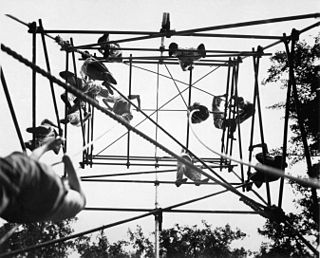
Operation Jedburgh was a clandestine operation during World War II in which three-man teams of operatives of the British Special Operations Executive (SOE), the U.S. Office of Strategic Services (OSS), the Free French Bureau central de renseignements et d'action and the Dutch and Belgian armies in exile were dropped by parachute into occupied France, the Netherlands and Belgium. The objective of the Jedburgh teams was to assist allied forces who invaded France on 6 June 1944 with sabotage and guerrilla warfare, and leading local resistance forces in actions against the Germans.

The Special Forces Tab is a service school qualification tab of the United States Army, awarded to any soldier completing the Special Forces Qualification Course at the U.S. Army John F. Kennedy Special Warfare Center and School, Fort Liberty, North Carolina. Soldiers who are awarded the Special Forces Tab are authorized to wear it, as well as the green beret for the remainder of their military careers, even when not serving in a Special Forces command.

The United States Naval Special Warfare Command (USNSWC), also known as NAVSPECWARCOM and WARCOM, is the naval component of United States Special Operations Command, the unified command that oversees and conducts the nation's special operations and missions.

Operation Freshman was the codename given to a British airborne operation conducted in November 1942 during World War II. It was the first British airborne operation using Airspeed Horsa gliders, and its target was the Vemork Norsk Hydro hydrogen electrolysis plant in Telemark, Norway which produced heavy water as a by-product.
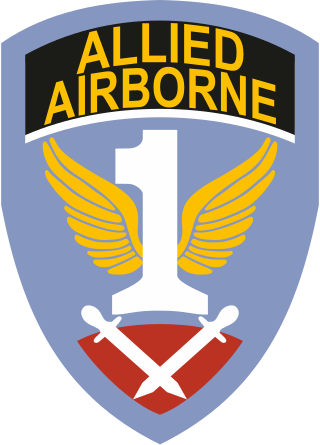
The First Allied Airborne Army was an Allied formation formed on 2 August 1944 by the order of General Dwight D. Eisenhower, the Supreme Allied Commander of the Allied Expeditionary Force.
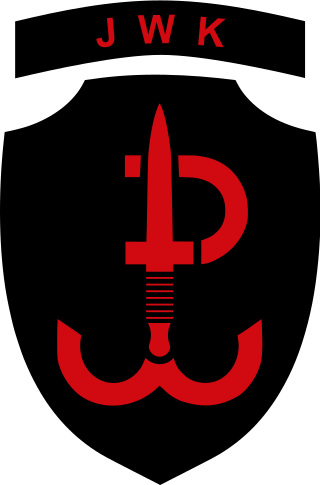
The Jednostka Wojskowa Komandosów, commonly called JWK and formerly known as 1 Pułk Specjalny Komandosów, is one of six special forces units currently operating within Poland's Centrum Operacji Specjalnych - Dowództwo Komponentu Wojsk Specjalnych. JWK was formed in 1961 and is the oldest still active Polish special operations unit. The unit is located in Lubliniec, Poland.
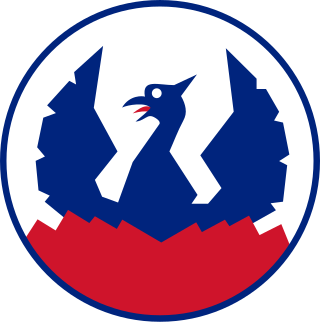
Force 136 was a far eastern branch of the British World War II intelligence organisation, the Special Operations Executive (SOE). Originally set up in 1941 as the India Mission with the cover name of GSI(k), it absorbed what was left of SOE's Oriental Mission in April 1942. The man in overall charge for the duration of its existence was Colin Mackenzie.

The Psychological Warfare Division of Supreme Headquarters Allied Expeditionary Force was a joint Anglo-American organization set-up in World War II tasked with conducting (predominantly) white tactical psychological warfare against German troops and recently liberated countries in Northwest Europe, during and after D-Day. It was headed by US Brigadier-General Robert A. McClure. The Division was formed from staff of the US Office of War Information (OWI) and Office of Strategic Services (OSS) and the British Political Warfare Executive (PWE).
National governments deal in both intelligence and military special operations functions that either should be completely secret, or simply cannot be linked to the sponsor. It is a continuing and unsolved question for governments whether clandestine intelligence collection and covert action should be under the same agency. The arguments for doing so include having centralized functions for monitoring covert action and clandestine HUMINT and making sure they do not conflict, as well as avoiding duplication in common services such as cover identity support, counterespionage, and secret communications. The arguments against doing so suggest that the management of the two activities takes a quite different mindset and skills, in part because clandestine collection almost always is on a slower timeline than covert action.
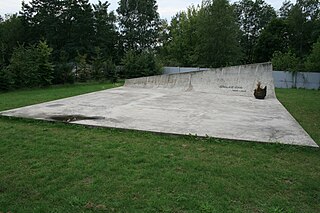
Stalag XI-A was a German World War II prisoner-of-war camp (Stammlager), located just to the east of the village of Altengrabow and in the south of Dörnitz in Saxony-Anhalt, about 90 km (56 mi) south-west of Berlin.

Special forces or special operations forces (SOF) are military units trained to conduct special operations. NATO has defined special operations as "military activities conducted by specially designated, organized, selected, trained and equipped forces using unconventional techniques and modes of employment".
Major Jacques Theodore Paul Marie Vaillant de Guélis was a Welsh-born French Special Operations Executive (SOE) agent during the Second World War. de Guélis was initially in the British Expeditionary Force in France in 1940 and later joined SOE and parachuted into France to organise resistance networks. He was badly injured in a motor accident in May 1945 and later died of his injuries in the hospital. He is buried in his home town of Cardiff.

The Royal Thai Army Special Warfare Command also known as Pa Wai Airborne is the special forces of the Royal Thai Army. Its headquarters are King Narai Camp in Lopburi.















